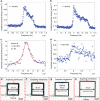Manufacture and characterization of graphene membranes with suspended silicon proof masses for MEMS and NEMS applications
- PMID: 34567632
- PMCID: PMC8433294
- DOI: 10.1038/s41378-019-0128-4
Manufacture and characterization of graphene membranes with suspended silicon proof masses for MEMS and NEMS applications
Abstract
Graphene's unparalleled strength, chemical stability, ultimate surface-to-volume ratio and excellent electronic properties make it an ideal candidate as a material for membranes in micro- and nanoelectromechanical systems (MEMS and NEMS). However, the integration of graphene into MEMS or NEMS devices and suspended structures such as proof masses on graphene membranes raises several technological challenges, including collapse and rupture of the graphene. We have developed a robust route for realizing membranes made of double-layer CVD graphene and suspending large silicon proof masses on membranes with high yields. We have demonstrated the manufacture of square graphene membranes with side lengths from 7 µm to 110 µm, and suspended proof masses consisting of solid silicon cubes that are from 5 µm × 5 µm × 16.4 µm to 100 µm × 100 µm × 16.4 µm in size. Our approach is compatible with wafer-scale MEMS and semiconductor manufacturing technologies, and the manufacturing yields of the graphene membranes with suspended proof masses were >90%, with >70% of the graphene membranes having >90% graphene area without visible defects. The measured resonance frequencies of the realized structures ranged from tens to hundreds of kHz, with quality factors ranging from 63 to 148. The graphene membranes with suspended proof masses were extremely robust, and were able to withstand indentation forces from an atomic force microscope (AFM) tip of up to ~7000 nN. The proposed approach for the reliable and large-scale manufacture of graphene membranes with suspended proof masses will enable the development and study of innovative NEMS devices with new functionalities and improved performances.
Keywords: NEMS; Nanoscale materials.
© The Author(s) 2020.
Conflict of interest statement
Conflict of interestThe authors declare that they have no conflict of interest.
Figures















References
-
- Bolotin KI, et al. Ultrahigh electron mobility in suspended graphene. Solid State Commun. 2008;146:351–355. doi: 10.1016/j.ssc.2008.02.024. - DOI
-
- Lau CN, Bao W, Velasco J. Properties of suspended graphene membranes. Mater. Today. 2012;15:238–245. doi: 10.1016/S1369-7021(12)70114-1. - DOI
-
- Zang X, Zhou Q, Chang J, Liu Y, Lin L. Graphene and carbon nanotube (CNT) in MEMS/NEMS applications. Microelectron. Eng. 2015;132:192–206. doi: 10.1016/j.mee.2014.10.023. - DOI
LinkOut - more resources
Full Text Sources
Other Literature Sources
Miscellaneous
